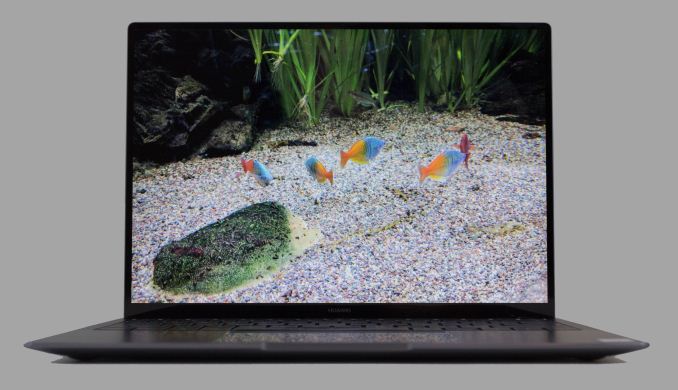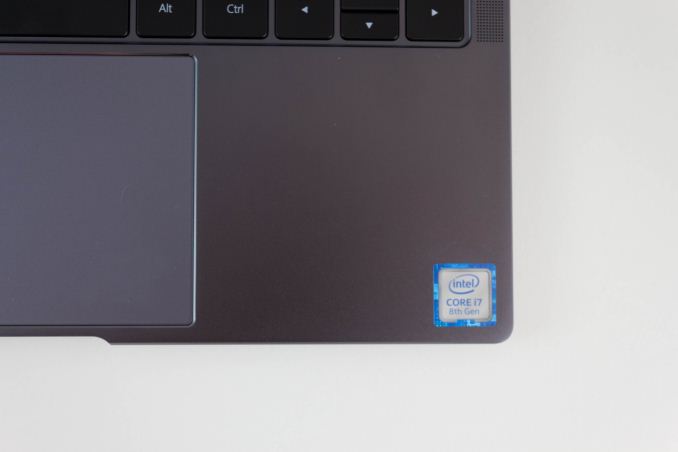The Huawei MateBook X Pro Review: Calling Out The Competition
by Brett Howse on June 27, 2018 8:00 AM EST
Huawei has not been in the PC game very long, but in just a short couple of years they certainly raised the bar for the competition in the Ultrabook category. Today we’re taking a look at the latest Huawei MateBook X Pro, and with this release, the traditional PC makers need to stand up and take notice.
The MateBook X Pro features a laundry list of features you’d look for in a new Ultrabook. The PC world has fully embraced the thin-bezel revolution, and Huawei has taken this to an impressive 91% screen to body ratio on their latest Ultrabook, which features just 4.4 mm bezels all the way around. The small jump from the previous generation’s 88% was achieved by relocating the webcam to the keyboard, which we’ll cover later. In addition to the thin bezels, Huawei has kept the fantastic 3:2 aspect ratio display as the MateBook X, but increases the display size and resolution, to 13.9-inches and 3000x2000 respectively.
The laptop offers pretty much every feature you could hope for in thin and light Ultrabook, with Intel’s 8th generation Core U series processors in the i5-8250U and i7-8550U, both of which are Kaby Lake Refresh with four cores and eight threads. The Core i7 model also comes with NIVIDIA’s GeForce MX150 GPU, with 2 GB of GDDR5 and 384 CUDA cores, which should offer substantially more grunt than the Intel HD 630. RAM is 8 GB of the Core i5 and 16 GB of LPDDR3 on the Core i7, which is the maximum amount of LPDDR3 you can fit in a U series laptop.
| Huawei Matebook X Pro (2018) | |||
| Core i7 With MX 150 (model reviewed) |
Core i5 Without MX 150 |
||
| Processor | CPU | Intel Core i7-8550U | Intel Core i5-8250U |
| Cores | Quad Core with HT | Quad Core with HT | |
| Base Freq | 1.8 GHz | 1.6 GHz | |
| Turbo Freq | 4.0 GHz | 3.6 GHz | |
| L3 Cache | 8 MB | 6 MB | |
| TDP | PL1 = 15W | PL1 = 15W | |
| Graphics | NVIDIA MX150 2GB GDDR5 384 CUDA Cores |
Intel HD 630 24 EUs 300-1100 MHz |
|
| Display | 13.9-inch 3000x2000 LTPS 100% sRGB 450 nits 1500:1 contrast ratio 10-point touch |
||
| DRAM | 16 GB LPDDR3 | 8 GB LPDDR3 | |
| Storage | 512 GB NVMe PCIe 3.0 x 4 |
256 GB NVMe PCIe 3.0 x 4 |
|
| Wireless | Intel Dual Band Wireless-AC 8275 802.11ac 2x2:2 Dual Band |
||
| Connectivity | 1 x Type-C (Power and Data) 1 x TB3 (Power and Data) 1 x Type-A 3.5mm TRRS |
||
| Camera | Spring Latch 1MP |
||
| Battery | 57.4 Wh | ||
| Dimensions | H x W x D | 304 x 217 x 14.6 mm | |
| Mass | ~1.33 kg | < 1.33 kg | |
| Price | $1499.99 USD | $1199.99 USD | |
But the fun hasn’t stopped there. Huawei has also outfitted the MateBook X Pro with two USB-C ports which both support power and data, and one of them is also Thunderbolt 3 enabled. For those that still need access to normal USB, which is most people, there’s also a USB-A port as well. There’s no SD card slot, which would be the one thing that might be missed, but it’s a small sacrifice.
The MateBook X Pro also ships with the Intel Dual Band Wireless-AC 8265 network adapter, which is a 2x2:2 adapter with 80 MHz channels, meaning a maximum connection speed of 867 Mbps, and integrated Bluetooth 4.2. Since Intel added MU-MIMO support, it’s easily the adapter of choice with great performance and high reliability.
Huawei has managed to pack in pretty much everything you could wish for in an Ultrabook, but they’ve still kept a thin and light design which we’ll take a look at now.











77 Comments
View All Comments
MrSpadge - Wednesday, June 27, 2018 - link
I really like the meaningful and fairly priced separation between the i5 and i7 model - keep it simple and the upgrade noticeable to the user.SirCanealot - Wednesday, June 27, 2018 - link
Actually, I was thinking the same thing! For the sake of $300 I can upgrade almost everything on the system. For $300 to do that, it's quite a 'may as well' situation! :)DiscoDJ - Wednesday, June 27, 2018 - link
I know the internet is international in scope, but I do find it interesting that this article doesn't even mention the security issues the U.S. Govt. (whatever you may think of it, right now) has with Huawei or ZTE. Is there an article on this site somewhere that dismisses these concerns as unfounded?RedKiwi - Wednesday, June 27, 2018 - link
Reading through the summary of the House intelligence report on Huawei and ZTE, it seems more of a "not worth the risk" type of situation. Investigating hardware provided by Huawei and ZTE was out of the scope of the investigation. The House only questioned their involvement with the Chinese government. Both companies were unable to provide a satisfactory answer to the committee. By not allowing Huawei and ZTE to sell telecommunications equipment to US carriers, it removes the possibility of snooping even if there is no risk in the first place.I do believe consumer hardware Huawei makes is safe for general use. It might not be worth it for the government to risk.
On a side note, I wish some of these decisions would be made in other parts of the US government such as environmental laws.
vanilla_gorilla - Wednesday, June 27, 2018 - link
That's one of the most reasonable replies to that question I've seen.But we can't ignore the fact that in 2017 ZTE plead guilty to illegaly exporting US technology to Iran and North Korea.
Let me say that again: Iran and North Korea. In violation of international trade sanctions.
Then when the US called them on it, they agreed to reprimand employees and pay a fine. Instead, they only fired 4 officials and provided bonuses to 35 others. That's why the US Department of Commercen banned companies from buy ZTE products.
I don't think there's much more anaysis the government needs to do. Security is all based on trust and ZTE has zero. I wouldn't trust them as far as I could throw them.
ianmills - Wednesday, June 27, 2018 - link
Well the results sound about par for how the US handled their own 2009 financial crisis hahainvinciblegod - Wednesday, June 27, 2018 - link
"But we can't ignore the fact that in 2017 ZTE plead guilty to illegaly exporting US technology to Iran and North Korea. Let me say that again: Iran and North Korea. In violation of international trade sanctions."You say that like it's a super surprising thing but you'll be surprised to learn that many companies actually make a cost benefit analysis and more often than would be expected choose to illegally export US parts to those countries. They just know that if they get caught they will pay a fine and then everything is fine. Just search "companies that violate sanctions to iran" on google and you will see how many companies do it and get caught. ZTE obviously miscalculated on how much they could get away with in the plea deal.
invinciblegod - Wednesday, June 27, 2018 - link
Also, ZTE is not Huawei.Samus - Thursday, June 28, 2018 - link
LOL I was about to say the same thing.Oxford Guy - Tuesday, July 3, 2018 - link
Yep. If the benefit (the profit) outweighs the slap on the wrist (the cost) then why wouldn't any corporation go for it? Corporations are not people. They're financial mechanisms designed to enrich some people. They just happen to have real people to do some of that work (along with AI, robotics, etc.).